![]()
![]()
![]()
Use LEFT and RIGHT arrow keys to navigate between flashcards;
Use UP and DOWN arrow keys to flip the card;
H to show hint;
A reads text to speech;
17 Cards in this Set
- Front
- Back
|
When you think about international environment analysis, what are the main things you should think about?
|
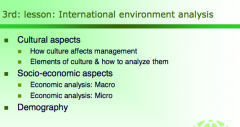
with cultural aspects, local taste is also very important (e.g. walmart being too clean in Indonesia or the Boots pop music full volume in Thailand)
|
|
|
What's the difference between management IN and OF culturally different environments?
|
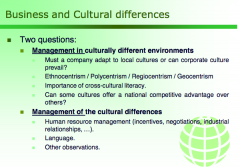
Management in is more the approach (e.g. ethnocentrism, things to consider) whereas management of is more the interactions, human resources decisions, language, etc
|
|
|
1. Define culture
2. List the characteristics of culture (6). 3. Define stereotypes |
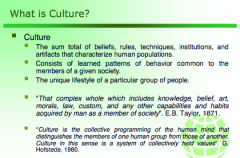
1. see above
2. Characteristics of culture include: 1. learned 2. shared 3. transgenerational 4. symbolic 5. patterned 6. adaptive 3. Stereotypes are assumptions about collective properties of a group that are applied to a particular member of that group |
|
|
How does culture affect all business functions(1) and managerial approaches(2)?
|

#1
- Marketing: variation in attitudes and values requires firms to use different marketing mixes - HR: evaluation of managers - Production and Finance: attitudes towards authority and attitudes towards change #2 - see above |
|
|
What are the sociocultural components to culture? Give an example of each.
|
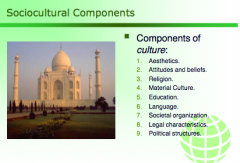
1. Aesthetics: art, music
2. Attitudes and Beliefs: attitude toward time, toward achievement and work, towards change 3. Religion: responsible for man attitudes / beliefs that shape behavior. (work ethic, authority, festivities, conflicts) 4. Material Culture: human-made objects (what people make, how, and why) and technology 5. Education: literacy rate, schools, per capita spend on education, educational mix (intl's b-schools), brain drain, reverse brain drain, women's education, disparities WITHIN a country 6. Spoken language: demarcate cultures, resort to english for technical words, saying disagreeable things, how your slogan changes, unspoken language 7. Societal Org: kinship, age, gender, free association, |
|
|
What is the importance of technology as part of the material culture to international companies?
|

Information Technology Era - internet economy
Consumption - different degrees in the use of automation in different countries |
|
|
What are the implications for international business for
1. country's political, economic, and legal environment 2. country's attractiveness |
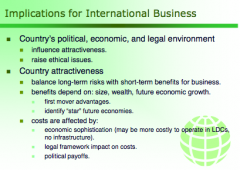
|
|
|
1. What is an international economic analysis
2. What are the sources for economic information 3. What are some economic issues for IB? |
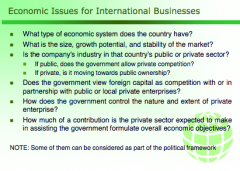
1. an analysis performed by a firm when it enters overseas markets - should provide data on both actual and prospective markets
2. reports from central or internatinoal banks, chamber of commerce, UN or worldbank, etc 3. see above |
|
|
1. What are the key economic forces?
2. What are the different kinds of economic systems (4) - explain each |

1. see above
2. - Market Economy: supply and demand determine economic decisions (e.g. USA) - Mixed Economy: gvt controls important sectors and can influence economic activity, generous welfare systems (e.g. most western european countries) - Centrally planned/command economy: all economic resources are owned by the get (e.g. Cuba, China) - Economies in a state of transition: deregulation, legal changes, privatization, (some central asia republics) |
|
|
1. When thinking about the general economic framework (which is one of the key economic forces on the prior slide), what are the 2 kinds of conditions we consider?
2. Explain each. (what are they and what are they important for) |
1. Demand Conditions and Factor Conditions
2. Demand conditions: critical for market-seeking investments. Market potential is determined by composition of home demand (nature of buyer needs) size of home demand growth of home demand internationalization of demand Factor Conditions: are inputs to the production process (HR, physical resources, knowledge, capital, infrastructure). These are especially critical for the production of goods. |
|
|
1. When we analyze the macro-economic situation, what are the things we must consider?
2. How does a company measure the importance between variables? |
1. GNI, PPP, Income Distribution, Private Consumption, Unit Labor Costs, Other variables (debt, FOREX, Interest rate, inflation)
2. The importance of each variable depends on the activity required to develop in a country |
|
|
1. What are the measures for national production? Explain each.
2. What are the exclusions? |
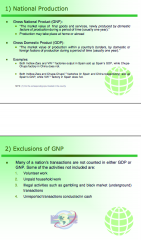
|
|
|
What is PPP?
Why is it a useful measure? |
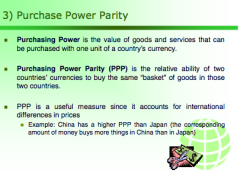
|
|
|
What is income distribution?
|
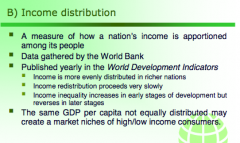
|
|
|
What is private consumption?
What are unit labor costs? |

|
|
|
1. How do foreign debt and exchange rates affect the firm abroad?
2. What are broader conceptions of development? 3. What is Human Development Index? 4. What model do we use for an economic analysis of the industry? |

1. See above
2. Amartya Sen says that development should be assessed by material output measures and is an economic and a political process that requires "democratization". 3. The Human Development Index is a function of life expectancy, PPP to meet basic needs) 4. Porter's 5 Forces |
|
|
Provide a summary for this section
|

|

